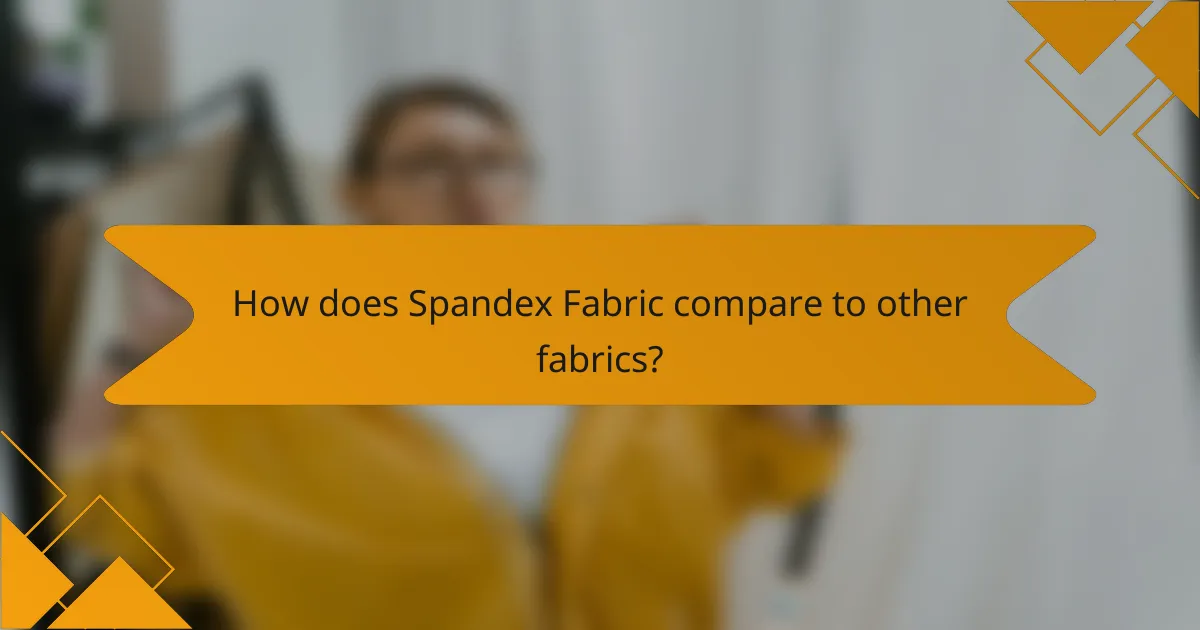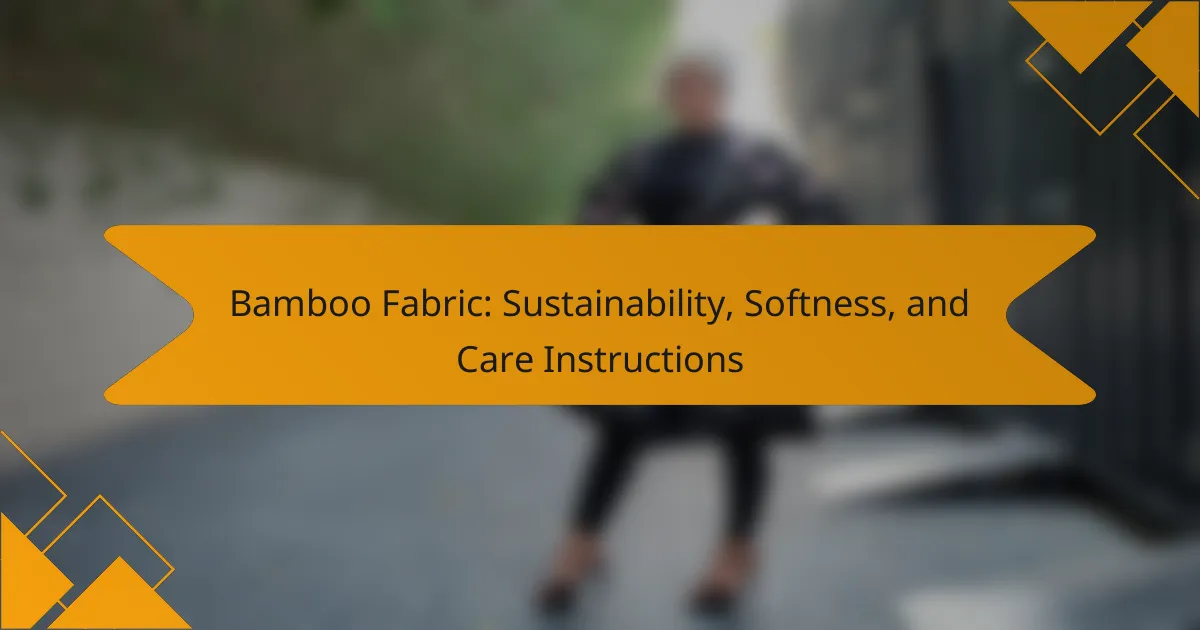Spandex fabric, a synthetic fiber made from polyurethane, is recognized for its remarkable elasticity, allowing it to stretch up to five times its original length while returning to its shape. This unique characteristic makes spandex ideal for form-fitting clothing, commonly found in athletic wear, swimwear, and undergarments. The fabric is often blended with other materials, such as cotton or polyester, to enhance comfort and fit. Recent trends highlight a focus on sustainability and eco-friendly production methods, with brands increasingly utilizing recycled materials. As the demand for activewear rises, innovations in spandex technology are emerging, emphasizing moisture-wicking properties and customization, reflecting consumer preferences for functionality and sustainability in apparel.

What is Spandex Fabric?
Spandex fabric is a synthetic fiber known for its exceptional elasticity. It is made from a polymer called polyurethane. Spandex can stretch up to five times its original length and return to its shape. This unique property makes it ideal for form-fitting clothing. Common applications include athletic wear, swimwear, and undergarments. Spandex is often blended with other fabrics to enhance comfort and fit. The invention of spandex dates back to the 1950s by chemist Joseph Shivers. Its popularity has since grown in the fashion and athletic industries due to its flexibility and durability.
How is Spandex Fabric made?
Spandex fabric is made through a chemical process involving the polymerization of polyurethane. The process typically starts with the creation of a prepolymer, which is formed by reacting a diisocyanate with a polyol. This mixture is then heated and mixed to create a viscous solution. The solution is extruded through a spinneret to form continuous filaments. These filaments are then solidified through a process called coagulation, usually in a bath containing a solvent. After solidification, the filaments are stretched to align the molecular structure, enhancing elasticity. Finally, the spandex fibers are dried, cut, and can be woven or knitted into fabric. The result is a highly elastic material known for its stretch and recovery properties, making it ideal for various applications in clothing and textiles.
What raw materials are used in Spandex production?
Spandex production primarily uses polyurethane as its main raw material. Polyurethane is a polymer that provides elasticity and strength. The production process also involves the use of chemicals such as dimethylformamide (DMF) and other solvents. These chemicals aid in the polymerization process. The combination of these materials results in the highly elastic fabric known as Spandex. According to the American Chemical Society, the properties of Spandex are largely due to the unique structure of polyurethane.
What processes are involved in creating Spandex Fabric?
The processes involved in creating Spandex fabric include polymerization, spinning, and finishing. First, polymerization occurs where polyurethane is synthesized from a reaction between a diisocyanate and a polyol. This creates a stretchy material with elastic properties. Next, the polymer is dissolved in a solvent to form a solution. This solution is then extruded through spinnerets to create filaments during the spinning process. These filaments are drawn to align the molecules, enhancing strength and elasticity. Finally, the fabric undergoes finishing processes, which may include dyeing, texturizing, and treating to improve performance and appearance. Each of these steps ensures that Spandex fabric achieves its characteristic stretch and durability, making it ideal for various applications in clothing and textiles.
What are the key characteristics of Spandex Fabric?
Spandex fabric is known for its exceptional elasticity and stretchability. It can stretch up to five times its original length and still return to its original shape. This unique characteristic makes it ideal for form-fitting clothing. Spandex is also lightweight and breathable, enhancing comfort during wear. The fabric is resistant to abrasion and has good recovery properties, maintaining its shape over time. Additionally, spandex is often blended with other fibers to improve the overall performance of garments. Its moisture-wicking properties help keep the wearer dry. Spandex is commonly used in activewear, swimwear, and undergarments. These characteristics contribute to its widespread popularity in the fashion and sports industries.
How does Spandex contribute to flexibility?
Spandex enhances flexibility due to its unique elasticity. The fiber can stretch up to five times its original length. This characteristic allows garments to conform closely to the body. Spandex returns to its original shape after stretching. This property provides freedom of movement in various activities. Athletes and dancers benefit from spandex’s ability to support dynamic motion. Studies show that spandex blends improve comfort and ease of movement in clothing. Therefore, spandex is essential for activewear and form-fitting garments.
What makes Spandex comfortable to wear?
Spandex is comfortable to wear due to its high elasticity and ability to stretch. This fabric can stretch up to five times its original length without losing its shape. The material’s lightweight nature contributes to a feeling of freedom and ease during movement. Spandex also has moisture-wicking properties, which help keep the skin dry and comfortable. It allows for breathability, reducing the risk of overheating. Additionally, spandex blends well with other fabrics, enhancing overall comfort. Its smooth texture minimizes friction against the skin. These characteristics make spandex a popular choice for activewear and everyday clothing.
What are the common uses of Spandex Fabric?
Spandex fabric is commonly used in activewear, swimwear, and undergarments. Its elasticity allows for a comfortable fit and freedom of movement. Athletes often wear spandex for its moisture-wicking properties. The fabric is also popular in dance and gymnastics apparel. Additionally, spandex is used in shapewear for body contouring. Its blend with other fabrics enhances durability and stretch. The fashion industry frequently incorporates spandex in casual and formal wear. Overall, spandex’s versatility makes it ideal for various clothing applications.
Which clothing items typically incorporate Spandex?
Clothing items that typically incorporate Spandex include leggings, activewear, and swimwear. These garments benefit from Spandex’s stretchability and comfort. Leggings often use Spandex for flexibility during movement. Activewear, like sports bras and tops, relies on Spandex for a snug fit. Swimwear incorporates Spandex to enhance mobility in water. Other items include fitted dresses and undergarments, which utilize Spandex for shaping. The inclusion of Spandex allows these items to maintain their shape and provide comfort.
How is Spandex used in various sports and activities?
Spandex is used extensively in various sports and activities due to its elasticity and comfort. Athletes wear spandex in running, cycling, and swimming for its ability to provide support and enhance performance. The material allows for a full range of motion, which is crucial in sports like gymnastics and dance. In team sports, such as soccer and basketball, spandex is used in uniforms for its moisture-wicking properties. Additionally, spandex blends are common in activewear, offering breathability and quick-drying capabilities. The fabric’s durability ensures that it withstands rigorous physical activity. Overall, spandex enhances athletic performance through its unique properties.

How does Spandex Fabric compare to other fabrics?
Spandex fabric is known for its exceptional elasticity compared to other fabrics. It can stretch up to 500% of its original length. This makes it ideal for form-fitting clothing. In contrast, cotton and polyester lack such high stretchability. Spandex also provides superior comfort and freedom of movement. It is often blended with other materials to enhance their flexibility. For example, leggings typically combine spandex with cotton or polyester. This blend allows for both breathability and stretch. Overall, spandex stands out due to its unique properties that cater to activewear and fitted garments.
What are the advantages of using Spandex over traditional fabrics?
Spandex offers superior elasticity compared to traditional fabrics. This elasticity allows garments to stretch significantly while retaining their original shape. Spandex can stretch up to five times its original length. Traditional fabrics often lack this level of flexibility. The comfort provided by spandex is enhanced by its ability to move with the body. This makes it ideal for activewear and form-fitting clothing. Additionally, spandex is lightweight and breathable, contributing to overall comfort. These properties make spandex a preferred choice in the fashion and athletic industries.
How does Spandex enhance performance in athletic wear?
Spandex enhances performance in athletic wear by providing superior elasticity. This elasticity allows garments to stretch and recover, enabling freedom of movement. Athletes benefit from this flexibility during various activities. Spandex also improves comfort by offering a snug fit without restricting motion. The fabric’s moisture-wicking properties help keep the wearer dry during intense workouts. Additionally, Spandex garments often feature breathability, which aids in temperature regulation. Studies indicate that garments with Spandex can enhance muscle support and reduce fatigue. Overall, Spandex plays a crucial role in optimizing athletic performance through its unique properties.
What are the limitations of Spandex compared to other materials?
Spandex has several limitations compared to other materials. It lacks breathability, which can lead to discomfort in hot conditions. Spandex is also prone to degradation from UV exposure, reducing its lifespan. Unlike cotton, it does not absorb moisture well, leading to a clammy feel. Spandex can lose its elasticity over time, especially with frequent washing. Additionally, it may not provide adequate insulation compared to wool or thermal fabrics. Spandex is often blended with other fibers, limiting its standalone use and versatility.
What factors influence the choice of Spandex in manufacturing?
The choice of Spandex in manufacturing is influenced by several factors. Key factors include elasticity, durability, and comfort. Spandex offers high elasticity, allowing garments to stretch significantly without losing shape. This property is essential for activewear and form-fitting clothing. Durability is another factor; Spandex resists wear and tear, making it suitable for long-lasting apparel. Comfort is critical as Spandex provides a soft feel against the skin. Additionally, moisture-wicking capabilities enhance performance in athletic wear. The blend with other fabrics also affects the choice, as it can improve texture and functionality. Manufacturers consider these attributes to meet consumer demands for performance and comfort in clothing.
How does the blend of Spandex with other fibers affect the final product?
The blend of Spandex with other fibers enhances the elasticity and comfort of the final product. Spandex, known for its stretchability, can significantly improve the fit of garments. When blended with cotton, the fabric becomes softer while retaining shape. A blend with polyester adds durability and moisture-wicking properties. This combination allows for a wider range of motion in activewear. According to a study by the Textile Research Journal, fabrics with Spandex blends show improved recovery after stretching. This means garments maintain their original shape longer. Blending Spandex with natural fibers can also provide breathability, making the fabric suitable for various climates.
What considerations are there for durability and maintenance of Spandex garments?
Durability and maintenance of Spandex garments require careful attention to washing and drying methods. Spandex is sensitive to heat, which can cause it to lose elasticity. Washing in cold water is recommended to preserve the fabric’s integrity. Avoiding bleach is essential, as it can damage the fibers. Line drying or using a low heat setting in the dryer helps maintain shape and elasticity. Regular inspection for wear and tear can prolong the lifespan of Spandex garments. Following these guidelines ensures optimal performance and durability of Spandex clothing.

What trends are emerging in the use of Spandex Fabric?
Emerging trends in the use of Spandex fabric include increased sustainability and eco-friendly production methods. Brands are focusing on recycled materials to create Spandex blends. The demand for activewear continues to rise, driving innovation in performance fabrics. Athleisure styles are becoming mainstream, integrating Spandex for comfort and flexibility. There is a growing interest in moisture-wicking and breathable properties of Spandex. Customization and personalization of activewear are also trending, allowing consumers to choose specific fabric blends. Additionally, advancements in technology are leading to smarter fabrics with enhanced features. These trends reflect consumer preferences for both functionality and sustainability in apparel.
How is sustainability impacting Spandex production?
Sustainability is significantly impacting Spandex production by driving the adoption of eco-friendly materials and processes. Manufacturers are increasingly using recycled fibers to create Spandex. This reduces waste and conserves resources. For example, brands like Nike and Adidas have introduced products made from recycled polyester blended with Spandex. Furthermore, sustainable production methods aim to minimize water and energy consumption. According to a 2021 report by Textile Exchange, the use of recycled materials in textiles could reduce greenhouse gas emissions by 30%. As a result, the textile industry is shifting towards more sustainable practices in Spandex production.
What innovations are being introduced in Spandex technology?
Recent innovations in Spandex technology include enhanced durability and eco-friendly production methods. Manufacturers are now developing Spandex blends that increase resistance to wear and tear. This improvement extends the lifespan of garments made with Spandex. Additionally, advancements in dyeing techniques are reducing water usage and chemical waste during production. Innovations also focus on incorporating moisture-wicking properties into Spandex fabrics. This feature enhances comfort during physical activities. Furthermore, companies are exploring bio-based alternatives to traditional synthetic fibers. These alternatives aim to reduce environmental impact while maintaining performance. The integration of smart textiles into Spandex is another emerging trend. This allows for the incorporation of sensors and other technologies into the fabric.
What should consumers know about caring for Spandex garments?
Consumers should know that caring for Spandex garments requires specific attention. Spandex is sensitive to heat and should be washed in cold water. It is best to use a gentle cycle to prevent damage. Avoid bleach and fabric softeners, as they can degrade the fibers. Air drying is recommended to maintain elasticity. If using a dryer, select a low heat setting. Regular care helps preserve the garment’s shape and longevity. Following these guidelines can extend the life of Spandex clothing significantly.
How can you prolong the life of Spandex clothing?
To prolong the life of Spandex clothing, wash it in cold water and avoid bleach. Cold water helps maintain the elasticity of Spandex fibers. Use a gentle cycle to reduce wear and tear. Air drying is recommended to prevent heat damage from dryers. Avoid prolonged exposure to direct sunlight, as UV rays can degrade Spandex. Store Spandex clothing in a cool, dry place to prevent moisture accumulation. These practices help preserve the integrity and longevity of Spandex garments.
What are common mistakes to avoid when washing Spandex items?
Common mistakes to avoid when washing Spandex items include using hot water and harsh detergents. Hot water can damage the elasticity of Spandex fibers. Harsh detergents may strip the fabric of its natural oils. Additionally, avoid using fabric softeners, as they can create a residue on Spandex. Do not wring or twist Spandex items, as this can lead to misshaping. Instead, gently press out excess water. Avoid drying Spandex in direct sunlight, which can cause fading and deterioration. Lastly, refrain from using high heat in the dryer; instead, opt for low heat or air drying to maintain the fabric’s integrity.
Spandex fabric is a synthetic fiber known for its exceptional elasticity, allowing it to stretch up to five times its original length while maintaining shape. The article covers the manufacturing process of spandex, including the raw materials used, key characteristics, and common applications in activewear, swimwear, and undergarments. It also discusses the advantages of spandex over traditional fabrics, its impact on athletic performance, and emerging trends in sustainability and technology within the industry. Additionally, the article provides care instructions for maintaining spandex garments and highlights the importance of blending spandex with other fibers for enhanced comfort and durability.


